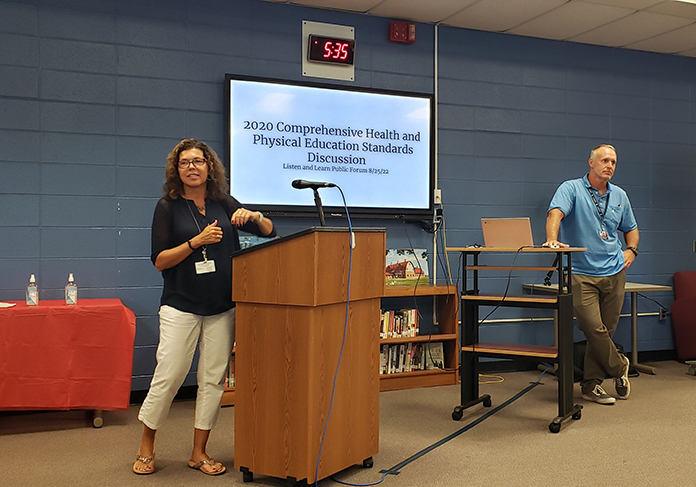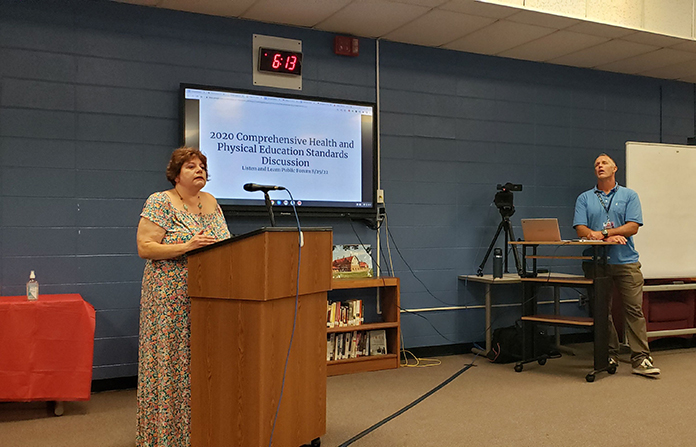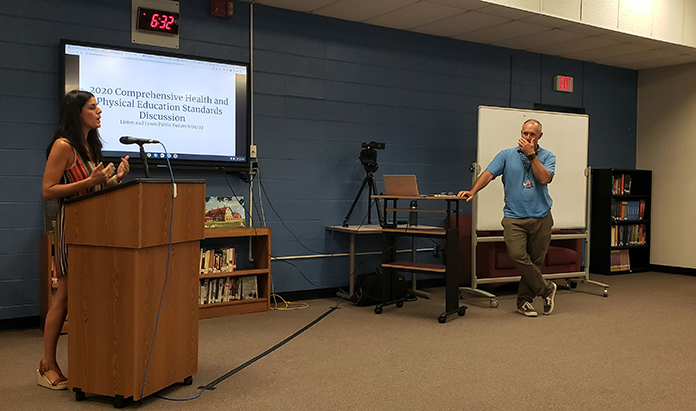
LACEY – The new school year begins this week but parents want to know what their children will be taught concerning sex education, the curriculum of which is in the process of being updated.
During a recent open public forum in the Lacey High School Media Center, parents let their voices be heard and most objected to what was being considered.
Assistant Superintendent for Curriculum and Instruction William Zylinski is overseeing the creation of the new curriculum that is in the process of being reviewed by a curriculum committee.
Zylinski showed a slide presentation that stated the standards and reflected on how health education teachers could convey that sensitive subject matter at each age level.
Also present were Board members Harold “Skip” Peters, Kim Klaus, Superintendent Vanessa Pereira and Michelle Amos, the district’ s supervisor for kindergarten through 5th grade. Tim Dowd, the supervisor for 6th through 12th grades joined the forum later after he was finished with another forum being held at the lecture hall at the high school.

Parents noted displeasure at the early time period for the forum and that another forum on a different topic was also being held at the same day and time.
One parent said he had to leave work early and would have to make up work time on Saturday but felt this subject was important. He advised administrators to hold vital forums later in the evening to allow for more parents to attend.
A Cedar Creek School mom also called for more transparency. “I have a seven-year-old boy and I don’t want any agenda pushed on him except his own when he decides whatever he wants to do,” she said.
The subject of parents opting out was a point of dispute as many felt that instead of opting out, parents should be first asked whether to opt in to the instruction.
Parent Tara DeLuca asked “can’t we just say no? I do not want an opt out – it should be an opt in.”
Zylinski explained that in going to the classroom portal online, parents must first read the form about opting out but that was done to verify that they read it. They could decide whether to opt-out later.
He said the curriculum was last updated in 2014 and had to be updated now guided by the State’s new standards. He stressed that parents did have a voice in how it would be taught.
“It isn’t being forced on you. There is an opt-out form,” Peters responded to parents in the audience where he sat. Parents questioned though if children who are opted out would be ostracized.
Zylinski said that for those students who feel uncomfortable and whose parents opt them out, there were school counselors who could assist them.
Another parent, Stacey Jackson, works as a case worker for child services. She had a slightly different view than most stating it was important for students to learn about what other students in the school might be coping with so far as gender identity issues.
“I’ve worked with children for 18 years now and I’m telling you that your kids know a lot more than you think they do because the world unfortunately has changed. Do you want them to learn from social media or do you want them to learn from an educated area?” Jackson asked.
Jackson said, “my son is going to be 10 and I’ve learned from work, that he needs to be educated about things. You have the option of not having your kid to learn it if you don’t want to but I feel it is very important for our kids to learn it. I’ve seen things that you can’t even imagine happen and they don’t know how to deal with it because they haven’t been taught anything about it.
The forum was recorded to allow for it to be played back to members of the administration and Board of Education. They will use it as part of their general review of the curriculum.
The assistant superintendent was frequently interrupted by parents seated in the audience and he pleaded with them to speak out on the record at the podium. He also urged parents to read the preliminary plans that are included on the school district’s website.
“We’re going to sit down and take your feedback and look at the next step,” Superintendent Pereira said. Zylinski said any content that could be deemed controversial within the preliminary curriculum would not be included in the opening weeks of the school year as the development stages continue.
A description of the health and physical education curriculum for each grade level it is available at laceyschools.org/Page/11366.

In 2020, the state updated their Comprehensive Health and Physical Education guidelines, and it encompasses a great deal more than sex and gender. It is 66 pages. There are entire pages on fitness, and just a few sentences on gender identity, but that is what some parents are concerned about. Other topics include addiction, nutrition, and resolving conflicts.
The state’s guidelines can be found here:nj.gov/education/cccs/2020/2020%20NJSLS-CHPE.pdf
Parents have expressed concerns that the state’s rules are causing students to be “indoctrinated” into lifestyles of which the parents wouldn’t approve, or they say the parents should be the ones having these conversations with the children. Examples of sex ed materials have been spread on social media, regardless of whether they were actually going to be used in a classroom.
Whenever parents bring up these points, school officials throughout Ocean County have continually said that while the state created the guidelines, each district was able to craft their own lessons. There is still an element of home rule.
According to the state document, “Today’s students are continually bombarded with physical, mental, and social influences that affect not only learning in school, but also the lifelong health of the citizens that schools are preparing for graduation. To that end, the New Jersey Student Learning Standards – Comprehensive Health and Physical Education (NJSLS-CHPE) were revised to address the need for students to gain knowledge and skills in caring for themselves, interact effectively with others, and analyze the impact of choices and consequences.”
One philosophy of education is that teachers shouldn’t just teach facts, but should create lifetime learners – something that lasts after graduation. One of the goals here is to create healthy exercise and nutrition habits for the rest of their lives.
There is language about “health literacy,” and that if someone doesn’t know anything about health issues, then they won’t know where to turn if something is wrong. They might not even know if something is wrong. Thus, there are topics for older kids about consent, sexting, and sexual assault.
The lessons are split across age levels. The youngest is “by the end of 2nd grade.” The other steps are “end of 5th,” “end of 8th,” and “end of 12th.”
For example, the core idea for sexual health by the end of 2nd grade is “Every individual has unique skills and qualities, which can include the activities they enjoy such as how they may dress, their mannerisms, things they like to do.” By 5th grade, that has evolved into “All individuals should feel welcome and included regardless of their gender, gender expression, or sexual orientation.” The points under that, for end of 5th grade, are: “Describe gender-role stereotypes and their potential impact on self and others; Differentiate between sexual orientation and gender identity; Demonstrate ways to promote dignity and respect for all people (e.g. sexual orientation, gender identity and expression, race, ethnicity, socio-economic status, differing ability, immigration status, family configuration).”
One point of contention for some parents is that by the end of 8th grade, one of the guidelines is “Define vaginal, oral, and anal sex.”

The state’s guidance is based on best practices from throughout the nation. Educators have said that creating a place where schools welcome everyone regardless of gender identity will reduce suicide, drug abuse, and other harmful actions of teens who feel they don’t belong. In this case, it’s literally life or death for kids going through tough times.
Children are being asked to “respect and accept differences of an individual’s race, religion, gender identity, gender expression, ethnicity, disability, socioeconomic background, and perspectives of health-related decisions.”
The state requires that schools include the contributions of African Americans, people with disabilities, as well as lesbian, gay, bisexual, and transgender people “in an appropriate place.”
More than a dozen districts throughout the state have refused to implement the changes, resulting in threats of less state aid and suspension of professional licenses.






